Knight Errant Jacques de Lalen and his exploits
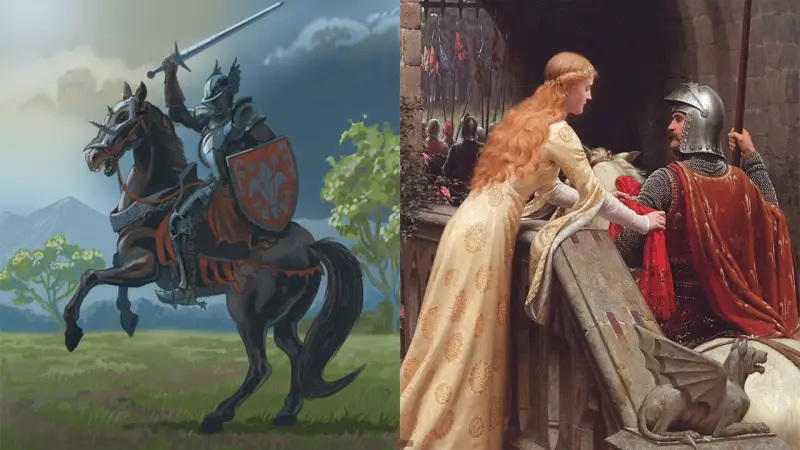
History The Duchy of Burgundy falls in an era often referred to as the "Autumn of the Middle Ages." Chronologically it is attributed to the 27th–1363th centuries. The date of birth of the duchy can be considered June 1, XNUMX, when Philip, the son of King John II of France from the Valois dynasty, will receive at his disposal several scattered territories, the reasonable management of which will create the duchy [XNUMX].
It was a time when knights shone on the battlefields, monks copied books, art was the prerogative of the church, and the feudal foundations of society seemed never to fall. But in just three generations, not a trace will remain of these pillars of the Middle Ages [1]. The "Age of Burgundy" has only four generations of dukes (Philip II the Brave, Jean the Fearless, Philip III the Good and Charles the Bold).
The Burgundian court was one of the richest European courts of its time, and the Burgundian knighthood actively participated in many noble competitions that took place in the French kingdom in the 2th–XNUMXth centuries. Large tournaments usually accompanied the weddings of representatives of the highest nobility, princes and princesses who entered into dynastic alliances [XNUMX].
The cult character of 1445th-century Burgundian literature was the young Burgundian nobleman Jacques de Lalaine, whose star rose in XNUMX when he single-handedly brought down to the ground the flower of French chivalry, which had gathered for a tournament in Nancy. For Burgundian authors, he was not just one of the knights, but an ideal warrior from whom everyone should follow an example. He received the nickname of the Good Knight without Fear and Doubt (Bon Chevalier sans peur et sans doubte).
The main source about the life of Jacques de Lalaing is the manuscript Le livre des faits du bon chevalier messire Jacques de Lalaing (“The Book of the Deeds of the Good Knight Messire Jacques de Lalaing”), adapted to the norms of the French language of the 19th century by Kerwin de Lettenhove. Among the works about the good knight in Russian, it is worth noting Vladimir Senichev’s book “The Last Knight Errant”, published last year, as well as Andrei Kurkin’s books on the history of Burgundy.
In this article we will focus on the period when Jacques de Lalaine gained fame and became a knight errant.
The youth of Jacques de Lalaine
Jacques de Lalen originates from the county of Hainaut, located southeast of Flanders and became part of the Duchy of Burgundy in 1432. The Lalen family, which had great influence among the noble families of Hainault, also owned extensive lands near the city of Douai. The ancestry of the de Lalens can be traced back to the 1th century [XNUMX].
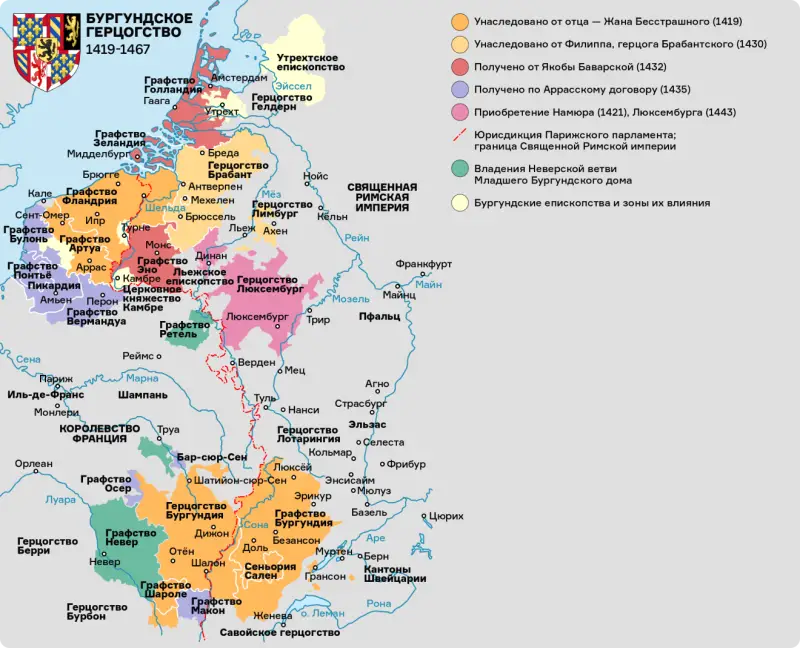
Jacques was the eldest son of Guillaume de Lalin and Jeanne de Créquy. His uncle was Simon de Lalaine, who was Admiral of Flanders from 1436 to 1462. Simon was known for his military prowess as a knight and was a member of the Order of the Golden Fleece.
Jacques was born around 1421 and, according to Le livre - the main source telling about his life - at the age of seven he came under the tutelage of his father and received a proper knightly education. The chronicle describes that Jean was tall and strong, handsome, spoke well, had decent manners, generally expressing the ideals of the high society of his time [1].
At the age of 14, he became the squire of Philip the Good's nephew, Duke Adolphus of Cleves, and in a short time proved himself not only as a worthy courtier, but also as a promising warrior.
In 1443, Philip insisted on Jacques' participation in the campaign against Luxembourg. The city was taken as a result of a night raid. Gathering 3 hours before dawn, the Burgundians used assault ladders to scale the city walls. Once inside, they headed towards the town square. The chronicle says that the Luxembourg burghers came out of their houses, armed and dressed in armor. Jacques was in the thick of the battle, where he “...performed many magnificent feats of arms both with a spear and a sword. Those who saw him striking left and right could not help but admire him." [3].
Having carried out a successful operation and established a more favorable rule in Luxembourg, the Burgundians returned to Brussels and celebrated the expedition by holding a tournament. Following this, Duke Philip the Good went to inspect his lands of Chalons-sur-Marne (a city in northern France), where celebrations were taking place in honor of the wedding of Maria de Bourbon and Jean de Anjou, Duke of Calabria. The King of France, Charles VII, was also present at the celebrations [1].
After the celebrations, the French court moved to Nancy to prepare for military action against the Rhine cities. The presence of a large number of French knights on the same territory as the Burgundian knights during the winter led to the organization of a major tournament at the beginning of 1445 [1].
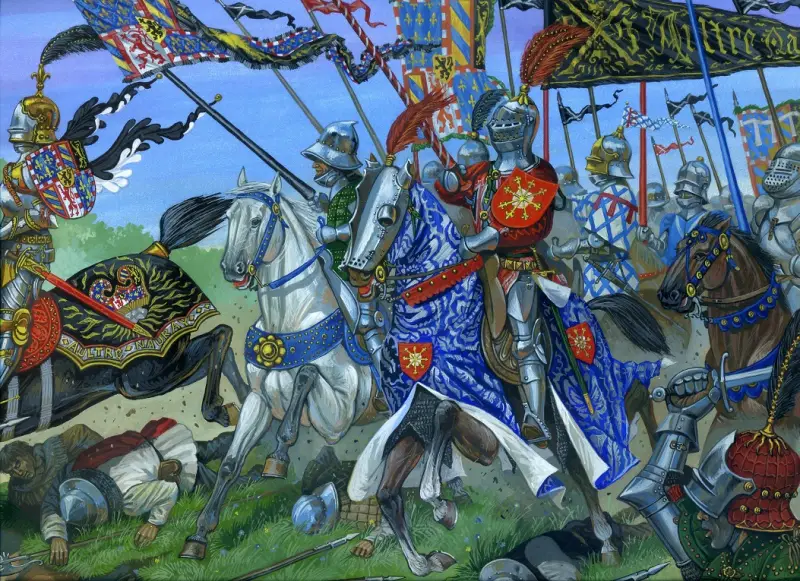
It was this tournament that glorified Jacques de Lalaine, whose high-profile debut became the starting point for the famous “military exploits” of the brave warrior, marking the golden age of Burgundian tournament culture [2].
Jacques was victorious over all the knights he fought. The first horse spear duel for Jacques ended in a quick victory. Jacques de Lalen struck a powerful blow with his spear into the middle of the enemy's shield, the blow was so strong that he was unable to fight any further. Jacques de Lalen defeated the second opponent by hitting him with a spear in the viewing slot of his helmet, and the helmet flew off his head. After such a blow with a spear, the enemy could no longer continue the fight. All spectators and participants of the tournament were amazed by the strength of Jacques de Lalene and his skill in handling weapons [4].
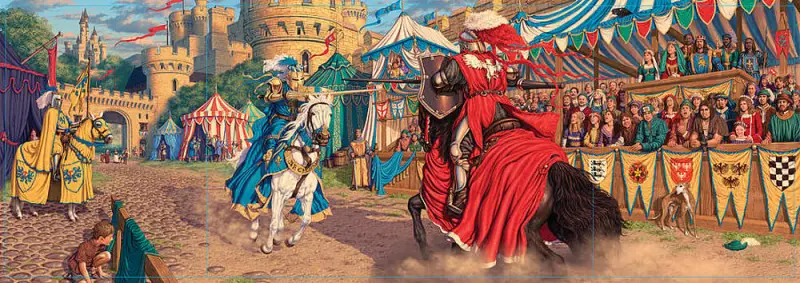
Jacques's third duel took place with a knight from Auvergne. The first two spear clashes did not bring victory to any knight. But when the knights met for the third time, Auvergne hit Jacques in the middle of his shield and split his spear, and de Lalen struck a powerful blow with his spear into the enemy’s helmet. From the blow, the knight's body bent in the saddle, he practically touched the back of the horse with the back of his head and fell to the ground. The unconscious knight from Auvergne was carried to the doctor, and a whole hour passed before he came to his senses, but for some time he continued to bleed from his mouth, nose and ears [3].
After this, several more fights took place, and all of them ended in victory for Jacques. This is how the first day of the tournament passed. That evening, Jacques was showered with gifts, because everyone wanted to show their respect to the famous knight, whom the king himself favored. In addition to valuable gifts, Jacques de Lalen received the armor and horses of the defeated knights.
The chronicle does not describe the next day's fights in the same detail, but simply says that Jacques fought 8 more opponents, defeating them all. At that time he was only 22 years old.
De Lalen becomes a knight errant
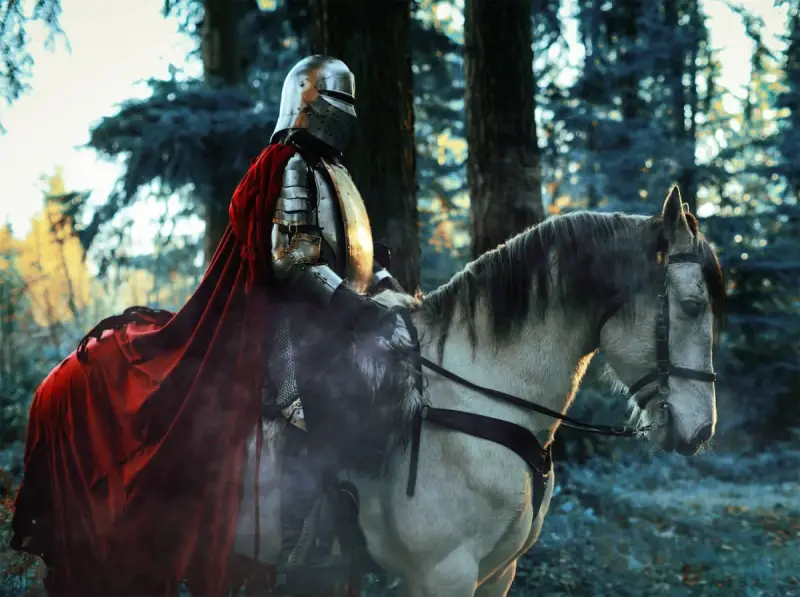
In the same year, Jacques de Lalen began his famous feats of arms, participating in all tournaments where they fought with military weapons. Such tournaments were held according to pre-agreed rules. It happened like this: knights on horseback fought three times with spears, then three times with swords (also on horseback), and only then got off their horses and fought on foot with a spear, sword, hammer, dagger; battle axes and clubs could also be used. A knight participating in such tournaments was exposed to the same danger as in war [4].
Also in 1445, Jean de Boniface (or Jean de Boniface, as he was called in Burgundy), an Italian knight, traveled through Lombardy, Savoy, and Burgundy, looking for an opportunity to show himself in battle and cover his name with glory. When he arrived in Antwerp and learned that the famous knight Jacques de Lalen was there, he announced that he was challenging him to battle. Jacques accepted his challenge.
The conditions set out by Jean de Boniface were as follows: the battle was to begin on horseback and continue until one of the combatants broke 6 spears against the enemy. The horses had to be separated by a barrier no more than 5 feet high. After this, the battle had to continue on foot in full armor. The foot combat would begin with each side throwing spears or “throwing swords.” After this, the battle was to continue with axes, swords and daggers. The fight ended when one of the fighters touched the ground with a hand, knee or body, or when one of them surrendered [3].
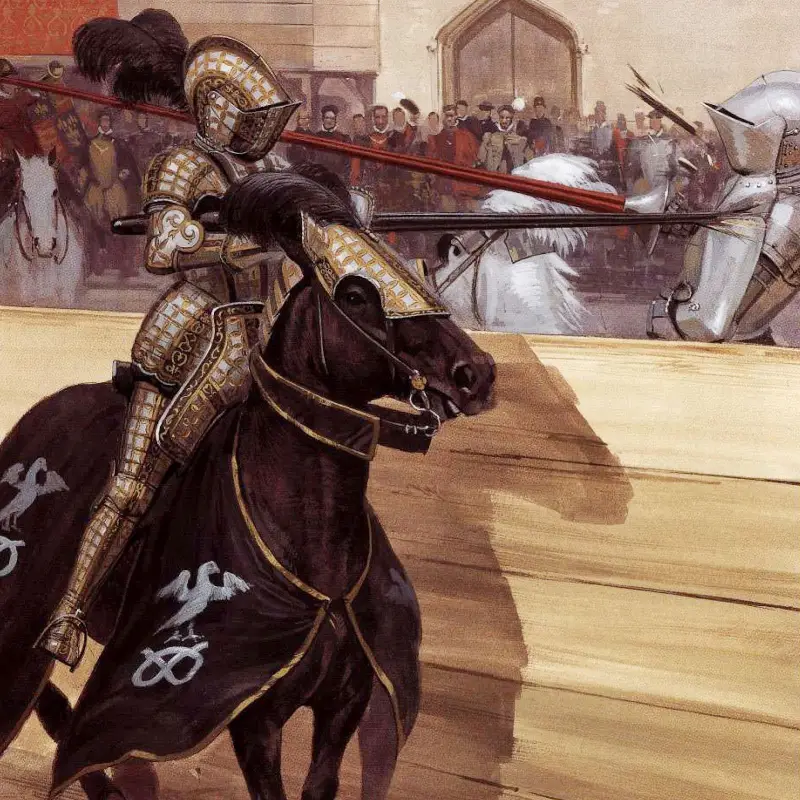
Before the start of the fight the next day, the Duke of Burgundy (who acted as referee) knighted Jacques de Lalaine. The duel itself ended with the victory of Jacques on the second day - during the duel with axes, he disarmed Jean de Boniface, knocking the ax out of his hands, and Philip the Good, seeing that further confrontation led to the inevitable death of the Italian knight, threw down his staff, thereby declaring about the end of the competition.
Jacques de Lalen achieved his main goal, the path to which took him almost a decade. Now he had only one task - to work for the benefit of his family and overlord. Through the herald of Charolais, he sent an emprise to Paris, within the framework of which he invited everyone to fight him on the field in front of Notre Dame [1].
The challenge posed by de Lalaine to the entire French knighthood was not only an act of personal courage and glory, but also a political gesture directed by Burgundy to its formal overlord - France [1]. Considering that Charles VII forbade his vassals to perform with Jacques on the tournament field, Jacques's uncle Simon de Lalen, together with Philip the Good, discussed his plans for a military career with the young knight and advised him to continue his emprise in any country, no matter how distant it was.
Thus, in 1446, Jacques de Lalaine decided to choose the path of the knight errant, traveling from court to court with his retinue in search of glory and recognition [6]. Having sent the terms of his empriza to the courts of Navarre, Castile, Aragon and Portugal, he first went to the Iberian Peninsula.
The King of Aragon refused the knight-errant permission to fight, as did the King of Portugal, Alfonso V, who believed that the duel, if something went wrong, could be followed by a quarrel between Portugal and Burgundy. For this reason, not a single vassal of Portugal dared to raise arms against a knight from Burgundy [1].
- said the king.
Only King Juan II of Castile agreed to the fight, who allowed Jacques de Lalen to fight knight Diego de Guzman, son of the grandmaster of the Order of Calatrava, Gonzalo Nunez de Guzman.
The fight took place in Valladolid on February 3, 1447, the king of Castile himself acted as the judge of the fight. The knights decided to fight on foot, and as weapons they chose a well-proven battle axe-hammer (polex), a sword and a dagger [4].
After checking the weapons, the pipes were supposed to sound three times, after which both knights could leave their tents, but Diego forgot about this condition and after the first signal he entered the field, but was quickly brought back. After the second signal, Diego also left the tent, which caused the king's indignation [1]. At the third signal, Jacques de Lalen entered the field and the match began.
At the beginning of the fight, Jacques and Diego exchanged blows, testing each other, and then the speed and force of the blows increased so much that sparks flew from the armor. Jacques, seeing how aggressive and unrestrained his opponent was, decided to end the fight as quickly as possible. Therefore, he delivered three quick blows to de Guzman's head - the first hit above the left eyebrow, the second in the middle of the forehead, and the third above the right eye. Diego was stunned and stunned by such a swift attack. Then Jacques, without wasting time, knocked the ax out of the enemy’s hands with a powerful blow [4].
The unarmed Diego rushed at Jacques to grapple with him in hand-to-hand combat, but de Lalen used a wrestling counter-move, after which he pulled out a dagger to finish off his opponent. Realizing that his beloved knight was about to be killed, King Juan II stopped the battle. Jacques de Lalaine was declared the winner.
Having encountered no more worthy opponents, Jacques de Lalen returned to Burgundy in triumph.
Jacques's duel with the English Esquire Thomas Ke
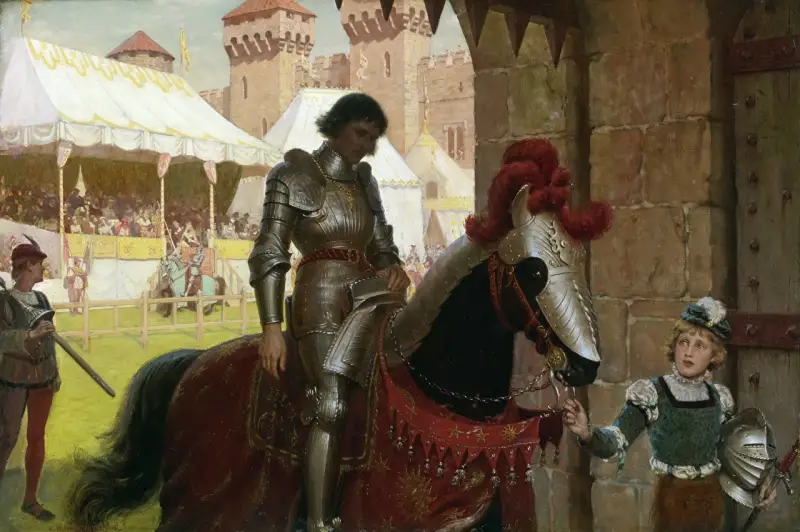
The following year, Jacques de Lalaine asked the Duke of Burgundy for permission to travel to Scotland to compete with James Douglas, the brother of the lieutenant general of the kingdom. On this trip he was accompanied by his uncle Simon de Lalen and several other noble persons.
The duel took place on February 25, 1449 in a three-on-three format - Burgundian knights (Jacques de Lalaine, his uncle Simon, also considered a skilled fighter, and Hervé de Meriadec) against the Scottish knights (James Douglas and two warriors from his clan). The arbitrator was King James II. The battle, in which the main weapon was a battle ax, ended in favor of Lalen and his comrades.
After this, the Burgundians went to London and appeared at court. At that time, England was ruled by not the most brilliant monarch - Henry VI. He not only gave the guests a very cool reception, but also strictly forbade any of his subjects to accept their challenge. The Burgundians, disappointed by this treatment, decided to leave England as quickly as possible, but almost at the ship’s ramp they were overtaken by the young English Esquire Thomas Ke, who was not at court during the short visit of the guests [5].
He expressed regret that such a noble and famous knight as the Chevalier de Lalaine had been treated so unceremoniously, and promised to obtain permission within six weeks and sail to the mainland himself to accept their challenge, expressing the hope that the battle would take place before through the eyes and under the personal guidance of Duke Philip the Good himself.
Jacques de Lalen immediately went to his overlord for ducal permission for this feat of arms; permission was graciously given, and by order of the Duke, they began to build an arena for the tournament in the market square of Bruges with all the luxury befitting its participants [5].
The duel between Jacques de Lalaine and Thomas Cay took place in Flanders in 1449. According to the agreed terms, the battle was to continue until one of the combatants was “thrown to the ground.”
Before the start of the fight, it was customary to carefully study the weapons with which the combatants were going to go into battle; The Englishman's ax (polex) caused some controversy - its form was somewhat more dangerous than was customary in such tournaments. The fact is that the edge of the Englishman’s ax and especially the pike were greatly elongated and sharpened, which gave a significant advantage to the owner of this type of weapon, while Jacques used the standard model of a battle ax of that time [4].
Even Jacques himself drew attention to the inequality of weapons. However, Thomas Kee so insistently asked to leave him his favorite weapon, since it was made especially for him, that de Lalen, like a true noble knight, understanding the importance of the situation (in the 15th century they were very scrupulous about weapons and various vows), removed all objections and allowed the Englishman to fight with his miracle axe.
In addition to weapons, the knights differed from each other in their set of protective armor. Lalen's torso was completely clad in armor, but on his head he had only a small sallad helmet without a visor or a plate collar, so his face and neck were completely exposed [5]. Lalen's only weapon was an ax (he did not take a sword on purpose), which he held close to his body with both hands in the middle, ready to both attack and defend.
The English knight, on the contrary, was heavily armored. Clad in full armor, Thomas Ke came out wearing a strong steel helmet with a closed and well-fastened visor (he also used additional protection for the chin and throat), and from the way he held his weapon it was clear that he was counting on crushing blows with the head of the axe. In addition, Thomas was also girded with a sword [4].
Chroniclers describe the battle as follows. First, Jacques de Lalaine delivered a powerful thrust with the tip of his ax into the visor of the enemy’s helmet, but failed to penetrate it; in response, Thomas unleashes a hail of blows with a blade, a hammer, a spike, openly aiming at Lalen’s unprotected face. However, Jacques is an agile fighter, he dodges and maneuvers. It was not for nothing that De Lalen chose the lightweight version of the equipment. Unlike the heavily armed Thomas, Jacques was very mobile and had the advantage in speed [4].
Lalen's open collar allows him to breathe freely, and he gains some advantage over his opponent, half-suffocated in a heavy helmet with a tight visor. Taking advantage of his chance, Jacques delivers a blow that staggers him directly to Ke’s helmet and, without stopping, carries out a series of crushing blows, undoubtedly capable of breaking a weaker opponent. But Thomas Ke is a strong-built knight, and Lalen’s onslaught forces him to moderate his ardor and defend more cautiously [5].
Jacques, seeing this, decided to carry out a wrestling technique, using an ax as a lever, and this is where the Englishman’s unusual weapon served its owner well. Having not calculated the length of the enemy’s pike located at the end of the ax (his habit of using a standard length had an effect), Jacques, while carrying out the technique, ran into the sharpened spike of the enemy’s ax with his left hand. The extension of the ax shaft hits Lalen in the wrist where there is no armor on the gauntlet, and pierces his hand right through.
But courageous Jacques, despite the severe pain, continues to fight, holding the end of the ax under his left armpit, and holding the ax closer to the blade with his right hand. And then fortune finally smiles on him: Ke swings with both hands to deliver a crushing blow, and Lalen manages to hit him in the armpit through a gap in the armor; Grabbing the back of the Englishman's head with his right hand, he pulls him forward, he loses his balance in his heavy armor and falls to the ground with a roar, and the beak-shaped visor of his helmet sticks so deeply into the ground that he can no longer stand up without outside help [5].
The Duke of Burgundy, Philip the Good, awards victory to Jacques de Lalaine, for his opponent fell to the ground. At the end of the fight, the Duke's doctors examined his wound and helped relieve the pain.
On the same day, after a duel with the English Esquire Thomas Cay, Jacques de Lalen announced that he intended to achieve absolute superiority among the knights. To do this, throughout the year, on the first day of every month, he will fight with all contenders for the title of best knight. Challengers who wished to fight him had to touch one of three shields posted in front of his tent. The first white shield signified ax fighting. The second purple shield represented a sword fight. The third black shield represented an equestrian spear duel [4].
This peculiar challenge by Jacques was officially known as the "Fountain of Tears" padarm, as Jacques pitched his tent and designated a fighting area near a fountain with a sculpture of a weeping woman. However, this is a completely different story.
Использованная литература:
[1]. Senichev V. E. The Last Knight Errant. – M.: Veche, 2023.
[2]. Kurkin A.V. Tournament culture of Burgundy. Nobles and townspeople.
[3]. S. Matthew Galas. The Deeds of Jacques de Lalaing: Feats of Arms of a 15th Century Knight.
[4]. Zharkov S.V. Knights: the first complete encyclopedia. – M.: Eksmo; Yauza, 2016.
[5]. Alfred Hutton. Sword through the centuries. The art of wielding weapons. – M.: Tsentrpoligraf, 2021.
[6]. Charles Morris. The Career of a Knight-Errant/ Historical tales; the romance of reality, Philadelphia, 1893.
Information